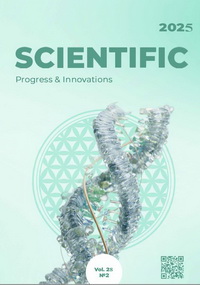Influence of changes in respiratory processes on erythropoiesis in young ruminants
DOI:
https://doi.org/10.31210/spi2025.28.02.32Keywords:
calves, erythropoiesis, asphyxia, hypoxia, hemoglobinAbstract
This work is devoted to a comprehensive analysis of the processes of erythropoiesis in newborn calves under normal conditions and asphyxia of varying severity, which is one of the main causes of mortality in young cattle. Asphyxia, which occurs as a result of impaired respiratory function during childbirth or immediately after birth, causes hypoxia, which affects hematological parameters, structural and functional characteristics of erythrocytes and metabolic processes in the body. Asphyxia, which occurs as a result of impaired respiratory function during childbirth or immediately after birth, causes hypoxia, which affects hematological parameters, structural and functional characteristics of erythrocytes and metabolic processes in the body. The work used an experimental approach, which included the study of three groups of calves (n=15): clinically healthy (control), with mild and severe asphyxia. The research was conducted in the conditions of a farm and the laboratory of the Department of Internal Medicine, Pharmacy and Biochemistry. The results showed that in healthy calves, the number of erythrocytes in the peripheral blood was 7.32±0.14×10¹²/l, while in calves with mild and severe asphyxia this figure increased to 7.44±0.18×10¹²/l and 8.36±0.12×10¹²/l, respectively (p<0.05 in the severe asphyxia group). In the group of calves with severe respiratory distress, the mean erythrocyte volume increased 1.14 times, and the width of the erythrocyte volume distribution increased 1.26 times. These changes may indicate an accelerated release of reticulocytes from the red bone marrow. This increase is a compensatory reaction to hypoxia, but is accompanied by a decrease in hemoglobin content (from 118.02±8.20 g/l in control to 96.08±5.44 g/l in calves with severe asphyxia, p<0.01) and blood oxygen capacity (from 120.84±3.54 vol.% to 108.24±2.46 vol.%, p<0.01), which indicates limited adaptation efficiency. The study was conducted using standard methods: counting erythrocytes in the Goryaev chamber, hemoglobin-cyanide method, and microcentrifugation for hematocrit. A new approach to studying the relationship between respiratory disorders and erythropoiesis is proposed, which takes into account not only quantitative indicators, but also structural and metabolic changes in erythrocytes. The results obtained have practical significance for veterinary medicine, in particular for the development of methods for early diagnosis of asphyxia and its correction through antioxidant therapy or oxygen therapy.
Downloads
Published
How to Cite
Issue
Section
License
Copyright (c) 2025 Scientific Progress & Innovations

This work is licensed under a Creative Commons Attribution 4.0 International License.

 Creative Commons Attribution 4.0 International Licens
Creative Commons Attribution 4.0 International Licens